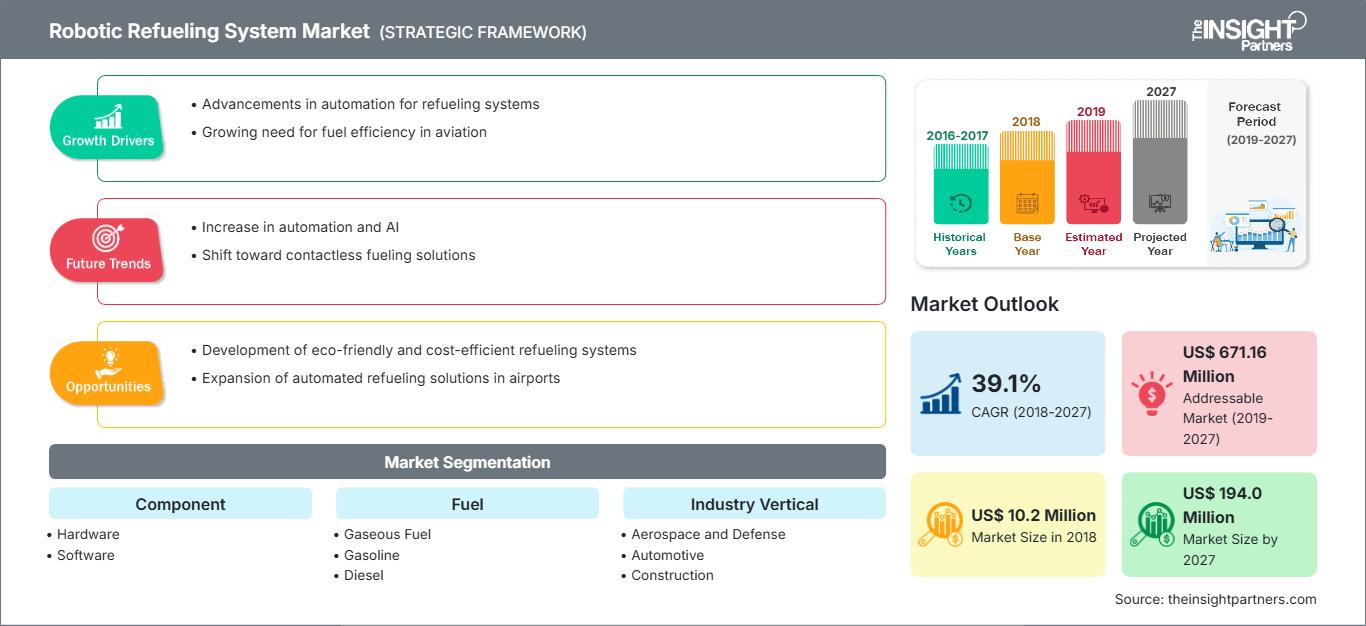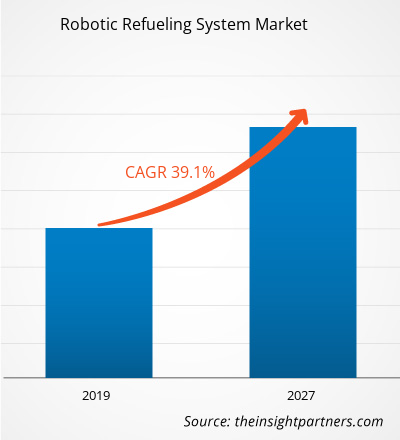The global robotic refueling system market accounted to US$ 10.2 Mn in 2018 and is expected to grow at a CAGR of 39.1% during the forecast period 2019 – 2027, to account to US$ 194.0 Mn by 2027.
Considerable acceleration for the demand for robots in various end-user industries owing to the continuing trend toward automation and sustained advanced technical improvements is majorly driving the robotics refueling system market. US is early and major adopter of this service and is still in its growing phase with implementation of several tools, and techniques pertaining to robotic refueling system. The presence of some of the world’s largest business firms coupled with huge competition in the region has driven the demands from the end-user industry for adoptions of robotic refueling system services. Additionally, US is also considered to be the hub of innovations and therefore, the technological disruptions take place in this part of the world first before spreading to the other regions. And the robotics refueling system market is becoming gradually prevalent across other developed and developing economies including Europe and MEA. Also, countries in APAC are experiencing a high growth in industrial sector thus, propelling the growth of robotic refueling system market.
Market Insights
Low cost of operation and flexibility of dispensing different fuels is going to act as a catalyst for the robotic refueling system market’s growth
For decades, fuel pumps have been operated by humans, thus, raising the total operational cost of managing the store and the pump. An operator has already been assigned for the task of fueling and managing the monetary operations. A robotic fueling station would eliminate the need for a human to potentially dangerous petrochemical fumes, avoiding driver’s exposure to extreme cold or hot temperatures during fueling, and reducing the labor costs associated with full-service fueling stations. Additionally, fueling a diesel car with petrol or vice versa has always been the most careless mistake while refueling. Robotic refueling systems eliminate the chances of wrong fuelling accidents as each vehicle would have an RFID tag which would inform the refueling station regarding the type of fuel used such as petrol, diesel, or natural gas.
Customize This Report To Suit Your Requirement
You will get customization on any report - free of charge - including parts of this report, or country-level analysis, Excel Data pack, as well as avail great offers and discounts for start-ups & universities
Robotic Refueling System Market: Strategic Insights

-
Get Top Key Market Trends of this report.This FREE sample will include data analysis, ranging from market trends to estimates and forecasts.
Mining industry to ensure robotic refuelling system market formidable growth rate
Usually, refueling facilities are managed by at least one person at all times and in mining, trucks can spend up to an hour per day traveling to refuel in isolated areas away from the pit. Automated refueling or robotic refueling can save considerable time as there is no staffing required for an automatic/robotic solution; thus, refueling stations are able to be placed in-pit or on the circuit so fleet productivity can be significantly enhanced. Simultaneously, mining companies are also considering to overcome microeconomic factors related to safety, security, and hazardous mining conditions to ensure the health of their workforce. Even though deep-rooted robotic refueling implications are yet to gain the sustenance of the industry, many companies have started using containerized robotic fueling stations to alleviate the risks arising out of hazardous working environments at the mines and production sites. The usage of robotic fueling systems the mining industry is currently aligned towards safeguarding human safety in hazardous and risky operations. Cost optimization is another area that is explored with the help of robotics in mining.
Component Insights
The major components of a robotic refueling system consists of hardware and software. The hardware segment include various sensors and systems such as vehicle positioning system, control system, robotic arm, fuel dispensing system and sensors such as position sensors and proximity. One of the critical components of robotic refueling system is their software. Software is mere algorithms that guide the robotic is from the vehicle and insert the fuel nozzle perfectly into the fuel inlet.
Fuel Insights
Fossil fuels such as gasoline, diesel, natural gasses and bio diesel have been the driving force of many machineries and vehicle for over decades now. Majority of vehicles running on the road are running mostly on gasoline owing to their less emission of exhaust gasses as compared to diesel.
Industry Vertical Insights
Various industries have considered robotic refueling system to eliminate any risk associated with refueling and exposure to harmful petrochemical fumes to humans. Aerospace and defense is the largest industry vertical of robotic refueling system market owing to various numbers of pilot projects in the U.S. and Europe region.
Report Coverage
Some of the market initiatives were observed to be most adopted strategy in the global robotic refueling system market. Few of the recent market initiatives are listed below:
2018: Fanuc Corporation announced expansion of its production capacity by the construction of three new factories. The new construction is aimed to increase the capacities of ROBOT, ROBOSHOT and ROBOCUT.
2018: Fuelmatics received an order for two Fuelmatics 5000 units from a US-based oil company, which have massive fuel station in various states of US. The systems would be installed for public use in a station near JFK airport.
2018: KUKA, MHP, and Munich Represent one vision, a new SmartFactory as a Service. The new service uses Industry 4.0 and digitalisation which enables new manufacturing methods and require new business models.
The regional trends and factors influencing the Robotic Refueling System Market throughout the forecast period have been thoroughly explained by the analysts at The Insight Partners. This section also discusses Robotic Refueling System Market segments and geography across North America, Europe, Asia Pacific, Middle East and Africa, and South and Central America.
Robotic Refueling System Market Report Scope
| Report Attribute | Details |
|---|---|
| Market size in 2018 | US$ 10.2 Million |
| Market Size by 2027 | US$ 194.0 Million |
| Global CAGR (2018 - 2027) | 39.1% |
| Historical Data | 2016-2017 |
| Forecast period | 2019-2027 |
| Segments Covered |
By Component
|
| Regions and Countries Covered |
North America
|
| Market leaders and key company profiles |
|
Robotic Refueling System Market Players Density: Understanding Its Impact on Business Dynamics
The Robotic Refueling System Market is growing rapidly, driven by increasing end-user demand due to factors such as evolving consumer preferences, technological advancements, and greater awareness of the product's benefits. As demand rises, businesses are expanding their offerings, innovating to meet consumer needs, and capitalizing on emerging trends, which further fuels market growth.

- Get the Robotic Refueling System Market top key players overview
GLOBAL ROBOTIC REFUELING SYSTEM MARKET SEGMENTATION
Global Robotic Refueling System market – By Component
- Hardware
- Software
Global Robotic Refueling System Market – By Fuel
- Gaseous Fuel
- Gasoline
- Diesel
- Others
Global Robotic Refueling System Market – By Industry Vertical
- Aerospace & Defense
- Automotive
- Construction
- Oil & Gas
- Mining
- Others
Global Robotic Refueling System market – By Geography
-
North America
- U.S.
- Canada
- Mexico
-
Europe
- France
- Germany
- UK
- Russia
- Italy
- Rest of Europe
-
Asia Pacific (APAC)
- China
- India
- Japan
- Australia
- South Korea
- Rest of APAC
-
Middle EAST & Africa (MEA)
- South Africa
- Saudi Arabia
- UAE
- Rest of MEA
-
South America
- Brazil
- Argentina
- Rest of SAM
Global Robotic Refueling System Market - Company Profiles
- Scott
- KUKA
- Fanuc
- Fuelmatics
- Neste
- Rotec Engineering
- Gazprom Neft
- Mine Energy Solutions
- Plug Power, Inc.
- Shaw Development LLC
- Historical Analysis (2 Years), Base Year, Forecast (7 Years) with CAGR
- PEST and SWOT Analysis
- Market Size Value / Volume - Global, Regional, Country
- Industry and Competitive Landscape
- Excel Dataset
Recent Reports
Testimonials
Reason to Buy
- Informed Decision-Making
- Understanding Market Dynamics
- Competitive Analysis
- Identifying Emerging Markets
- Customer Insights
- Market Forecasts
- Risk Mitigation
- Boosting Operational Efficiency
- Strategic Planning
- Investment Justification
- Tracking Industry Innovations
- Aligning with Regulatory Trends





















 Get Free Sample For
Get Free Sample For